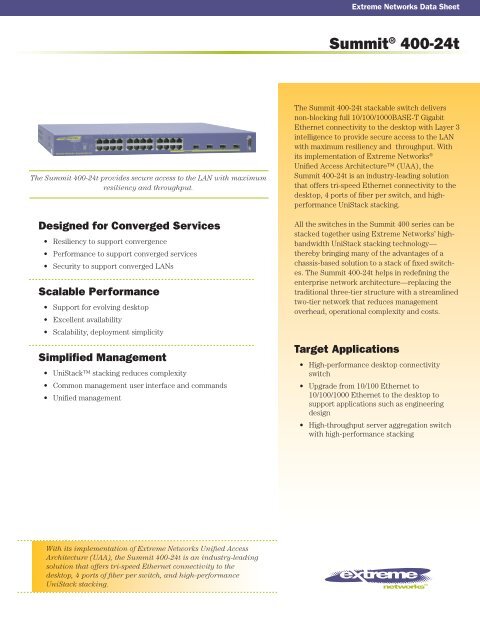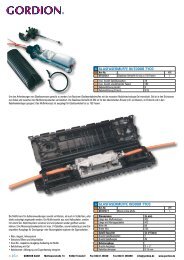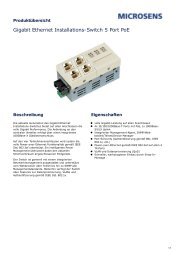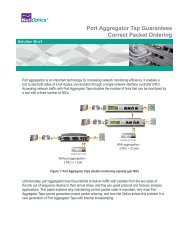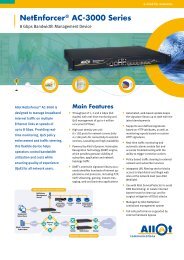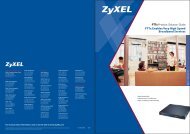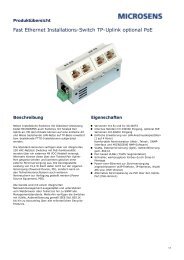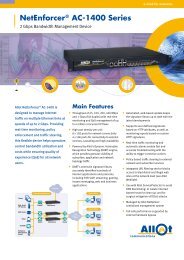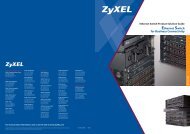Create successful ePaper yourself
Turn your PDF publications into a flip-book with our unique Google optimized e-Paper software.
Extreme Networks Data Sheet<br />
Summit ® <strong>400</strong>-<strong>24t</strong><br />
The Summit <strong>400</strong>-<strong>24t</strong> provides secure access to the LAN with maximum<br />
resiliency and throughput.<br />
Designed for Converged Services<br />
• Resiliency to support convergence<br />
• Performance to support converged services<br />
• Security to support converged LANs<br />
Scalable Performance<br />
• Support for evolving desktop<br />
• Excellent availability<br />
• Scalability, deployment simplicity<br />
Simplified Management<br />
• UniStack stacking reduces complexity<br />
• Common management user interface and commands<br />
• Unified management<br />
The Summit <strong>400</strong>-<strong>24t</strong> stackable switch delivers<br />
non-blocking full 10/100/1000BASE-T Gigabit<br />
Ethernet connectivity to the desktop with Layer 3<br />
intelligence to provide secure access to the LAN<br />
with maximum resiliency and throughput. With<br />
its implementation of Extreme Networks ®<br />
Unified Access Architecture (UAA), the<br />
Summit <strong>400</strong>-<strong>24t</strong> is an industry-leading solution<br />
that offers tri-speed Ethernet connectivity to the<br />
desktop, 4 ports of fiber per switch, and highperformance<br />
UniStack stacking.<br />
All the switches in the Summit <strong>400</strong> series can be<br />
stacked together using Extreme Networks’ highbandwidth<br />
UniStack stacking technology—<br />
thereby bringing many of the advantages of a<br />
chassis-based solution to a stack of fixed switches.<br />
The Summit <strong>400</strong>-<strong>24t</strong> helps in redefining the<br />
enterprise network architecture—replacing the<br />
traditional three-tier structure with a streamlined<br />
two-tier network that reduces management<br />
overhead, operational complexity and costs.<br />
Target Applications<br />
• High-performance desktop connectivity<br />
switch<br />
• Upgrade from 10/100 Ethernet to<br />
10/100/1000 Ethernet to the desktop to<br />
support applications such as engineering<br />
design<br />
• High-throughput server aggregation switch<br />
with high-performance stacking<br />
With its implementation of Extreme Networks Unified Access<br />
Architecture (UAA), the Summit <strong>400</strong>-<strong>24t</strong> is an industry-leading<br />
solution that offers tri-speed Ethernet connectivity to the<br />
desktop, 4 ports of fiber per switch, and high-performance<br />
UniStack stacking.
Extreme Networks Data Sheet<br />
Designed for Converged Services<br />
The convergence of traditionally non-LAN services on top of growing enterprise applications brings greater demands,<br />
responsibilities, and threats to the network infrastructure. The Summit <strong>400</strong>-<strong>24t</strong>, designed for convergence, provides the<br />
mandatory resiliency to keep applications available, delivers the features and performance to support converged services,<br />
and provides unique protection from security threats.<br />
Resiliency to Support<br />
Convergence<br />
Link Redundancy<br />
Proper support for converged services<br />
requires link resiliency, which the<br />
Summit <strong>400</strong>-<strong>24t</strong> provides through an<br />
extensive set of Layer 1 through Layer 3<br />
link redundancy options. For example:<br />
• Layer 1: Software redundant port–<br />
so simple and easy to deploy that it<br />
requires no supporting protocols or<br />
timers to configure.<br />
• Layer 2: Standard Spanning Tree<br />
and Rapid Spanning Tree, plus the<br />
extremely fast convergence of<br />
Ethernet Automatic Protection<br />
Switching (EAPS), which is capable<br />
of preserving sessions of latency<br />
sensitive applications such as Voiceover-IP<br />
(VoIP) through link failure.<br />
• Layer 3 dual homing, and ESRP<br />
which supports dual homing at both<br />
Layer 2 and Layer 3.<br />
.<br />
Rapid Convergence Resiliency<br />
The Summit <strong>400</strong>-<strong>24t</strong> provides EAPS, the<br />
RFC 3619 link layer resiliency protocol<br />
pioneered by Extreme Networks. Since<br />
EAPS fails over in less than 50 milliseconds<br />
in most deployments, the<br />
Summit <strong>400</strong>-<strong>24t</strong> recovers from faults<br />
without disrupting latency-sensitive<br />
sessions such as VoIP calls. This helps to<br />
ensure toll-quality voice and pictureperfect<br />
video.<br />
Highly Resilient Stacking<br />
UniStack stacking assures continuing<br />
availability of converged services.<br />
Redundant paths between every switch<br />
and 100% master redundancy protect<br />
the stack. The aggregation of links on<br />
multiple switches and creation of<br />
redundant uplinks on multiple switches<br />
enhances link redundancy.<br />
Performance to Support<br />
Converged Services<br />
Quality of Service (QoS)<br />
Extreme Networks pioneered QoS over<br />
local area networks. The Summit <strong>400</strong>-<strong>24t</strong><br />
is no exception, with its eight hardware<br />
QoS queues for finest granularity of<br />
prioritized traffic forwarding. Utilizing the<br />
power of eight QoS queues is ExtremeWare ®<br />
packet intelligence, which is able to<br />
examine packets from Layer 2 to Layer 4<br />
in the process of classifying traffic. With a<br />
powerful classification engine and fine<br />
queue granularity, Summit <strong>400</strong>-<strong>24t</strong><br />
provides consistent and timely packet<br />
delivery required to support converged<br />
services.<br />
Minimized Latency<br />
Latency and jitter can be lethal to realtime<br />
applications such as voice and video.<br />
The Summit <strong>400</strong>-<strong>24t</strong> was designed around<br />
a low latency and low jitter architecture in<br />
spite of the wealth of services it delivers.<br />
In particular, the UniStack stacking architecture<br />
was designed so that forwarding<br />
is always performed locally when the<br />
destination port is known, and when<br />
packets have to pass through the stack,<br />
they always take the shortest path.<br />
Non-Blocking Forwarding<br />
High-performance starts with a nonblocking<br />
architecture as delivered by the<br />
Summit <strong>400</strong>-<strong>24t</strong>. Any access switch that<br />
properly supports converged services must<br />
also examine every packet for QoS and<br />
security, and even more important is the<br />
ability to apply these features without<br />
degrading switch performance. The<br />
Summit <strong>400</strong>-<strong>24t</strong> supports all security, QoS,<br />
and management features at full line rate<br />
without negatively effecting applications.<br />
Security to Protect Converged LAN<br />
Line Rate Access Control Lists (ACLs)<br />
ACLs are one of the most powerful tools to<br />
Cost-Effective Network Design Using the Summit <strong>400</strong> Series<br />
The Summit <strong>400</strong> series of switches allows the traditional edge layer and aggregation<br />
layer of the network to be collapsed into a single access layer. A two-tier network that<br />
consists of an access layer and a core layer can reduce the number of switches required<br />
and hence reduce the network acquisition costs and network management costs.<br />
Depending on the size and geographic reach of the network, a two-tier network can be<br />
the most cost-effective design for a corporate network.<br />
control network resource utilization and<br />
to secure and protect the network.<br />
Summit <strong>400</strong>-<strong>24t</strong> supports up to 1,512<br />
ACLs based on Layer 2, 3 or 4 header<br />
information such as the MAC address, IP<br />
source/destination address, or protocol.<br />
Intelligent Network Access<br />
Summit <strong>400</strong>-<strong>24t</strong> supports a comprehensive<br />
range of Network Login options by providing<br />
an 802.1x agent-based approach, a webbased<br />
(agentless) login capability for<br />
guests, and a MAC-based authentication<br />
model for devices. With these modes of<br />
Network Login, only authorized users and<br />
devices can connect to the network and be<br />
assigned to the appropriate VLAN.<br />
Multiple Supplicant Support<br />
Multiple supplicant support secures IP<br />
Telephony and wireless access. Converged<br />
network designs often involve the use of<br />
shared ports. Shared ports represent a<br />
potential vulnerability in a network. Multiple<br />
supplicant capability on the Summit <strong>400</strong>-<strong>24t</strong><br />
switch allows it to uniquely recognize and<br />
apply the appropriate policies for each<br />
user or device on a shared port.<br />
Media Access Control (MAC)<br />
MAC lockdown secures IP telephones,<br />
wireless Access Points (APs) and servers.<br />
The MAC address security/lockdown<br />
feature enables Summit <strong>400</strong>-<strong>24t</strong> to block<br />
access to any Ethernet port when the MAC<br />
address of a station attempting to access<br />
the port is different from the configured<br />
MAC address. This feature is used to “lock<br />
down” a device like an IP telephone, an AP<br />
or a server to a specific port.<br />
Host Integrity Checking<br />
Host integrity checking helps keep infected<br />
or non-compliant machines off the network.<br />
Summit <strong>400</strong>-<strong>24t</strong> supports a host integrity<br />
or end point integrity solution that is based<br />
on the Trusted Computing Group model.<br />
Denial of Service (DoS) Protection<br />
If a Summit <strong>400</strong>-<strong>24t</strong> switch detects an<br />
unusually large number of packets in the<br />
CPU input queue, it will assemble ACLs<br />
that automatically stop these packets from<br />
reaching the CPU. After a period of time,<br />
the ACLs are removed. If the attack<br />
continues, they are reinstalled.<br />
© 2005 Extreme Networks, Inc. All rights reserved. Summit <strong>400</strong>-<strong>24t</strong> Data Sheet—Page 2
Extreme Networks Data Sheet<br />
Scalable Performance<br />
Networks are undergoing a transition from simple Fast Ethernet data connectivity to converged services and new applications<br />
over LAN which demand new infrastructure services: streaming media, VoIP, data analysis and simulations, all of which require<br />
expanded bandwidth, rapid resiliency, and precise QoS. The Summit <strong>400</strong>-<strong>24t</strong> provides these services in one multi-featured<br />
platform.<br />
Support for the Evolving Desktop<br />
Legacy Support<br />
With Plug and Play auto-sense on every<br />
port, attaching legacy devices is a breeze.<br />
With the Summit <strong>400</strong>-<strong>24t</strong>, existing 10 Mbps<br />
or 100 Mbps devices are transparently<br />
supported, and new security and management<br />
benefits become immediately available.<br />
.<br />
Gigabit Evolution<br />
Gigabit Ethernet is a stable, mature<br />
technology that provides the highest<br />
available bandwidth to the desktop. The<br />
combination of low-cost Gigabit Ethernet<br />
NICs and embedded gigabit interfaces<br />
and increasingly bandwidth hungry<br />
Enterprise applications is driving the<br />
demand for gigabit to the desktop, for<br />
which the Summit <strong>400</strong>-<strong>24t</strong> is the perfect<br />
switch, with its line-rate Layer 2 and<br />
Layer 3 gigabit forwarding, QoS and<br />
resiliency to support demanding<br />
applications.<br />
Future Applications<br />
The Summit <strong>400</strong>-<strong>24t</strong> already provides<br />
low latency and jitter plus the ability to<br />
prioritize based on an extensive set of<br />
packet header information that the most<br />
challenging of future applications is<br />
likely to require. This combination of<br />
performance plus packet intelligence,<br />
coupled with line-rate forwarding and<br />
extensive resiliency options, makes the<br />
Summit <strong>400</strong>-<strong>24t</strong> an obvious choice to<br />
help future-proof the LAN access layer<br />
for future converged applications such<br />
as desktop training, video conferencing<br />
and IP Telephony.<br />
Excellent Availability<br />
Link Redundancy<br />
To assure constant availability of<br />
wireless access, Summit <strong>400</strong>-<strong>24t</strong><br />
provides a plethora of redundancy<br />
features including Spanning Tree and<br />
Rapid Spanning Tree that are commonly<br />
provided, and much more. For example,<br />
software redundant port makes one link<br />
redundant to another very simply, with no<br />
protocol overhead. For latency sensitive<br />
applications, EAPS is capable of failing<br />
over in 50 milliseconds, fast enough to<br />
sustain a VoIP session. At Layer 3 there<br />
are three more options: OSPF ECMP,<br />
VRRP, and ESRP for incredibly scalable<br />
deployment of link resiliency.<br />
Power Redundancy—External<br />
Power System<br />
An important component of the continuous<br />
service capability of the Summit <strong>400</strong>-<strong>24t</strong> is<br />
its External Power System that provides<br />
immediate backup power in the unlikely<br />
event that the internal AC power supply<br />
fails, or in case the primary AC power<br />
input source has problems. The External<br />
Power System for Summit <strong>400</strong>-<strong>24t</strong> is<br />
comprised of two components: compact<br />
one rack unit (1RU) tray which accepts up<br />
to two power modules, and a 160 watt power<br />
module that provide 1:1 power redundancy<br />
for 100% backup power, together helps<br />
to ensure uninterrupted LAN access and<br />
continuous service availability.<br />
Forwarding Performance<br />
When management or security applications<br />
are enabled, some switches bog down and<br />
become network bottlenecks. Not so the<br />
Summit <strong>400</strong>-<strong>24t</strong>, with line-rate packet<br />
processing and forwarding performance,<br />
even when complex ACLs, Network Login,<br />
or other Layer 2, 3, or 4 features are enabled.<br />
This is because all packet processing is<br />
done in packet processing ASICs and not<br />
in software—the benefit is unimpeded<br />
traffic flow and LAN availability.<br />
Scalability, Deployment<br />
Simplicity<br />
Installation Flexibility<br />
With its compact 1RU footprint, finding rack<br />
space to deploy the Summit <strong>400</strong>-<strong>24t</strong> is<br />
trivial. A deployment of 192 gigabit ports<br />
only requires 14 inches of space. Further<br />
enhancing its deployment flexibility is the<br />
convenience of UniStack stacking that can<br />
link all these ports into a highly redundant,<br />
easily managed unit that, unlike a chassis,<br />
does not require contiguous allocation of<br />
rack space.<br />
Voice Grade Service Everywhere<br />
Granular QoS, low latency, and low jitter<br />
enable voice quality connections.<br />
Summit <strong>400</strong>-<strong>24t</strong> supports a range of QoS<br />
technologies that can prioritize and predictably<br />
handle high priority traffic—policing<br />
or rate limiting on ingress, 802.1q tagging<br />
and DiffServ marking, and shaping on egress<br />
with eight queues per port. The<br />
Extreme Networks tradition of building<br />
products with low latency and jitter<br />
continues with the Summit <strong>400</strong>-<strong>24t</strong>—<br />
allowing network managers to build networks<br />
with low end-to-end latency and jitter.<br />
Plug and Play<br />
Summit <strong>400</strong>-<strong>24t</strong> includes several quick<br />
install features that simplify its deployment<br />
into legacy locations as technology upgrades<br />
or into brand new installations. Every<br />
copper gigabit port is auto-sense and trispeed<br />
to easily conform to the attached<br />
device. Every port auto-senses the polarity<br />
of the attached cable and adapts automatically,<br />
so there is no need to worry about<br />
crossover versus straight-through cables.<br />
Every copper port can optionally test a<br />
cable connection for faults to accelerate<br />
deployment of new LANs. And every port<br />
supports Link Layer Discovery Protocol<br />
(LLDP) to sense and configure to LLDP<br />
compliant attached devices.<br />
Benefits Of UniStack Stacking<br />
The Summit <strong>400</strong> family with UniStack stacking architecture is designed to support converged services. The significant throughput<br />
provided by UniStack stacking––up to 160 gigabits per second (Gbps) per stack, and the distributed, shortest path forwarding––<br />
provide performance competitive with some chassis switches. Resiliency is of key importance for these applications. Availability is<br />
assured by redundant bidirectional ring architecture and n-1 master redundancy, distributed Layer 2 and Layer 3 link aggregation and<br />
link redundancy, and distributed uplinks.<br />
UniStack stacking on the Summit <strong>400</strong> family delivers the best of both worlds: the benefits of a chassis at the cost of a stackable, in an<br />
architecture designed to support today’s evolving LAN applications. The resulting network simplification results in lower management<br />
and maintenance costs, while enhancing overall availability.<br />
© 2005 Extreme Networks, Inc. All rights reserved.<br />
Summit <strong>400</strong>-<strong>24t</strong> Data Sheet—Page 3
Stack Port 1 Stack Port 2<br />
Stack Port 1 Stack Port 2<br />
Stack Port 1 Stack Port 2<br />
Stack Port 2 Line Card<br />
Stack Port 1 Line Card<br />
Stack Port 2 Line Card<br />
Stack Port 1 Line Card<br />
Stack Port 2 Line Card<br />
Stack Port 1 Line Card<br />
Power<br />
Cable Line<br />
M Hz<br />
10/10/100<br />
Power<br />
Cable Line<br />
M Hz<br />
10/10/100<br />
Power<br />
Cable Line<br />
M Hz<br />
10/10/100<br />
Redundant Power<br />
100-240 V<br />
10/10 Hz<br />
Redundant Power<br />
100-240 V<br />
10/10 Hz<br />
Redundant Power<br />
100-240 V<br />
10/10 Hz<br />
Extreme Networks Data Sheet<br />
Simplified Management<br />
Network management and maintenance can be challenging, especially for IT departments managing complex converged<br />
networks while under the pressure to reduce staff and expenses. For all organizations, any repetitive management operation<br />
taxes skilled resources, draining valuable productivity. The Summit <strong>400</strong>-<strong>24t</strong> offers relief through the management simplification<br />
provided by UniStack stacking. By making a stack of switches appear to be a virtual modular switch, the ExtremeWare<br />
UniStack architecture allows all ports in the stack of switches to be configured in one management session.<br />
UniStack Stacking Reduces<br />
Complexity<br />
Single Point of Management<br />
With UniStack stacking, up to eight<br />
Extreme Networks Summit switches,<br />
including the Summit <strong>400</strong> and<br />
Summit 200 families and the<br />
Summit 300-24, appear as a single<br />
network element managed through a<br />
single IP address, with the stack<br />
representing a single managed object<br />
inside an enterprise management tool<br />
such as EPICenter ® management suite<br />
from Extreme Networks. Having a single<br />
IP address for configuration, changes<br />
and upgrades yields dividends in saved<br />
time.<br />
.<br />
Easy Adds/Drops<br />
UniStack stacking also simplifies network<br />
expansions or changes. Adding new access<br />
ports to the LAN is as simple as turning<br />
on stacking in a new Summit <strong>400</strong>-<strong>24t</strong><br />
and adding it to an existing stack, similar<br />
to adding a new module to a modular<br />
switch, except that no space-consuming<br />
chassis is required. Similarly, moving the<br />
Summit <strong>400</strong>-<strong>24t</strong> to a new location is<br />
convenient, since the transferred switch<br />
can stand alone or become part of<br />
another stack.<br />
UniStack Stacking Architecture<br />
- High Throughput<br />
- High Resiliency<br />
- Single Management Point<br />
Simple Redundancy<br />
Enhancement<br />
Because a stack of Summit <strong>400</strong>-<strong>24t</strong>s<br />
represents an n-times replication of traffic<br />
processors, management processors,<br />
memory and power supplies, the net resiliency<br />
of a UniStack stack is greater than<br />
the sum of its parts. Add to this the ability<br />
to distribute redundant uplinks on different<br />
switches and availability goes up even<br />
more, compared to a standalone switch.<br />
Highly Reliable Architecture<br />
UniStack stacking on Summit <strong>400</strong> switches<br />
is a highly resilient, bidirectional fullduplex<br />
ring architecture with n-1 stack<br />
master redundancy designed to survive<br />
the failure of a stacking link or switch in<br />
the stack. With a nominal transfer rate of<br />
20 Gbps and instantaneous transfers of 40<br />
Gbps per switch, a stack of eight switches<br />
can transfer up to 160 Gbps through the<br />
stack with highly reliable, completely<br />
distributed, shortest path forwarding.<br />
Common Management<br />
Interface<br />
Common Command Line Interface<br />
Edge to Core<br />
The Summit <strong>400</strong>-<strong>24t</strong> operates with the<br />
award-winning ExtremeWare software<br />
from Extreme Networks. ExtremeWare<br />
gives the Summit <strong>400</strong>-<strong>24t</strong> the same<br />
administrative interface as any<br />
ExtremeWare switch running in the<br />
network. This common interface reduces<br />
training time, time to configure or update,<br />
and management overhead.<br />
Common Feature Set<br />
The common feature set that the<br />
Summit <strong>400</strong>-<strong>24t</strong> shares with other switches<br />
from Extreme Networks that are controlled<br />
by license levels, simplifies and reduces<br />
the cost of managing an Extreme Networks–<br />
powered LAN. The Summit <strong>400</strong>-<strong>24t</strong> delivers<br />
a rich suite of features spanning the range of<br />
protocols to intelligently overseeing traffic,<br />
consistent and simple to deploy, enabling<br />
efficient, productive LAN management.<br />
Common Management<br />
EPICenter Enterprise LAN manager supports<br />
the Summit <strong>400</strong>-<strong>24t</strong>, either individually or<br />
in UniStack stacks, providing a global view<br />
to enhance IT staff productivity. Whether<br />
the LAN is managed via serial port, web,<br />
telnet or a network manager like EPICenter,<br />
ExtremeWare included with the<br />
Summit <strong>400</strong>-<strong>24t</strong> provides a uniform<br />
interface for common management, thus<br />
reducing the cost of management.<br />
Link Layer Discovery Protocol<br />
By incorporating LLDP, the Summit <strong>400</strong>-<strong>24t</strong><br />
reduces networking expenses by enabling<br />
Plug and Play installation of network<br />
devices, simplifying maintenance and<br />
reducing trouble-shooting time. With its<br />
support of IEEE 802.1ab, LLDP simplifies<br />
deployment of VoIP phones, wireless APs,<br />
cameras, and any device that supports this<br />
vendor independent protocol.<br />
Secure Management<br />
Security of management is of primary<br />
importance, especially for remotely managed<br />
LANs. The Summit <strong>400</strong>-<strong>24t</strong> provides essential<br />
secure management features to protect<br />
these critical resources. All administrative<br />
access is protected via very secure authentication<br />
using TACACS or RADIUS access<br />
control. Secure Shell (SSHv2) is available to<br />
protect management sessions from snooping;<br />
Secure Copy (SCP) protects configuration<br />
file downloads; and SNMPv3 protects management<br />
sessions using enterprise management<br />
tools such as EPICenter. With its full<br />
management security, Summit <strong>400</strong>-<strong>24t</strong><br />
simplifies safe remote management.<br />
Desktop Access Management<br />
Using ACLs to examine Layer 2, 3, and 4<br />
packet header information for security<br />
and traffic classification establishes the<br />
Summit <strong>400</strong>-<strong>24t</strong> as a premier access<br />
switch. Its ability to authenticate users<br />
at the LAN edge separates the<br />
Summit <strong>400</strong>-<strong>24t</strong> from the pack. These<br />
features and more, available in the<br />
ExtremeWare operating system shipped<br />
with the Summit <strong>400</strong>-<strong>24t</strong>, provide the full<br />
and robust access management that sets<br />
Summit <strong>400</strong>-<strong>24t</strong> apart from others.<br />
Figure 1: Summit <strong>400</strong>-<strong>24t</strong> UniStack Stack Cabling Illustration<br />
© 2005 Extreme Networks, Inc. All rights reserved.<br />
Summit <strong>400</strong>-<strong>24t</strong> Data Sheet—Page 4
MGMT FAN PSU-I PSU-E =<br />
MGMT FAN PSU-I PSU-E =<br />
MGMT FAN PSU-I PSU-E =<br />
STACK NO<br />
STACK NO<br />
STACK NO<br />
Stack<br />
Ports<br />
St-1<br />
St-2<br />
Stack<br />
Ports<br />
St-1<br />
St-2<br />
Stack<br />
Ports<br />
St-1<br />
St-2<br />
1 2 3 4 5 6 7 8 9 10 1 12 13 14 15 16 17 18 19 20 21 2 23 24<br />
1 2 3 4 5 6 7 8 9 10 1 12 13 14 15 16 17 18 19 20 21 22 23 24<br />
1 2 3 4 5 6 7 8 9 10 11 12 13 14 15 16 17 18 19 20 21 22 23 24<br />
CONSOLE<br />
CONSOLE<br />
CONSOLE<br />
MGMT =<br />
FAN =<br />
PSU-I =<br />
PSU-E =<br />
MGMT =<br />
FAN =<br />
PSU-I =<br />
PSU-E =<br />
MGMT =<br />
FAN =<br />
PSU-I =<br />
PSU-E =<br />
STACK NO<br />
STACK NO<br />
STACK NO<br />
Stack<br />
PortsSt-1<br />
St-2<br />
Stack<br />
PortsSt-1<br />
St-2<br />
Stack<br />
PortsSt-1<br />
St-2<br />
1 2 3 4 5 6 7 8 9 10 1 12 13 14 15 16 17 18 19 20 21 2 23 24<br />
1 2 3 4 5 6 7 8 9 10 1 12 13 14 15 16 17 18 19 20 21 2 23 24<br />
1 2 3 4 5 6 7 8 9 10 1 12 13 14 15 16 17 18 19 20 21 2 23 24<br />
CONSOLE<br />
CONSOLE<br />
CONSOLE<br />
Extreme Networks Data Sheet<br />
MGMT FAN PSU-I PSU-E =<br />
MGMT FAN PSU-I PSU-E =<br />
MGMT FAN PSU-I PSU-E =<br />
STACK NO<br />
STACK NO<br />
STACK NO<br />
Stack<br />
Ports<br />
St-1<br />
St-2<br />
Stack<br />
Ports<br />
St-1<br />
St-2<br />
Stack<br />
Ports<br />
St-1<br />
St-2<br />
1 2 3 4 5 6 7 8 9 10 1 12 13 14 15 16 17 18 19 20 21 22 23 24<br />
1 2 3 4 5 6 7 8 9 10 111 12 13 14 15 16 17 18 19 20 21 22 23 24<br />
1 2 3 4 5 6 7 8 9 10 11 12 13 14 15 16 17 18 19 20 21 22 23 24<br />
CONSOLE<br />
CONSOLE<br />
CONSOLE<br />
Target Applications<br />
Upgrade to Unified Access Edge<br />
The Summit <strong>400</strong> family delivers highperformance<br />
and cost-effective connectivity<br />
driven by networking trends such<br />
as the increasing number of IP telephones,<br />
wireless APs and other devices at the<br />
edge of the network, Gigabit Ethernet<br />
connections to the desktop, and the use<br />
of gigabit and 10 Gigabit Ethernet as an<br />
interconnect technology. The stackable<br />
Summit <strong>400</strong> family allows the traditional<br />
edge layer and aggregation layer of the<br />
network to be collapsed into a single<br />
Unified Access layer.<br />
3 Summit <strong>400</strong>-48t<br />
3 Summit <strong>400</strong>-<strong>24t</strong><br />
Network Core<br />
3 Summit <strong>400</strong>-48t<br />
3 Summit <strong>400</strong>-<strong>24t</strong><br />
Altitude<br />
350-2<br />
Altitude<br />
350-2<br />
Altitude<br />
350-2<br />
Altitude<br />
350-2<br />
Technology Refresh<br />
Summit <strong>400</strong>-<strong>24t</strong> offers a great opportunity<br />
to upgrade existing infrastructure to<br />
introduce higher performance and support<br />
for evolving LAN services. With its rich<br />
feature set and competitive price, the<br />
Summit <strong>400</strong>-<strong>24t</strong> covers emerging technology<br />
bases to help with future-proofing.<br />
3 Summit <strong>400</strong>-48t<br />
3 Summit <strong>400</strong>-<strong>24t</strong><br />
Altitude<br />
350-2<br />
Altitude<br />
350-2<br />
© 2005 Extreme Networks, Inc. All rights reserved.<br />
Summit <strong>400</strong>-<strong>24t</strong> Data Sheet—Page 5
Extreme Networks Data Sheet<br />
Technical Specifications<br />
Software<br />
ExtremeWare 7.5 Supported Protocols<br />
General Routing and Switching<br />
• RFC 1812 Requirements for IP Version 4<br />
Routers<br />
• RFC 1519 CIDR<br />
• RFC 1256 IPv4 ICMP Router Discovery (IRDP)<br />
• RFC 1122 Host Requirements<br />
• RFC 768 UDP<br />
• RFC 791 IP<br />
• RFC 792 ICMP<br />
• RFC 793 TCP<br />
• RFC 826 ARP<br />
• RFC 894 IP over Ethernet<br />
• RFC 1027 Proxy ARP<br />
• RFC 2338 VRRP<br />
• RFC 3619 Ethernet Automatic Protection<br />
Switching (EAPS) and EAPSv2<br />
• IEEE 802.1D – 1998 Spanning Tree Protocol (STP)<br />
• IEEE 802.1w – 2001 Rapid Reconfiguration for<br />
STP, RSTP<br />
• IEEE 802.1Q – 1998 Virtual Bridged Local Area<br />
Networks<br />
• EMISTP, Extreme Multiple Instances of<br />
Spanning Tree Protocol<br />
• PVST+, Per VLAN STP (802.1Q interoperable)<br />
• Extreme Standby Router Protocol (ESRP)<br />
• Static Unicast Routes<br />
• Software Redundant Ports<br />
VLANs<br />
• IEEE 802.1Q VLAN Tagging<br />
• IEEE 802.3ad Static configuration and dynamic<br />
(LACP) for server attached<br />
• IEEE 802.1v: VLAN classification by Protocol<br />
and Port<br />
• Port-based VLANs<br />
• MAC-based VLANs<br />
• Protocol-based VLANs<br />
• Multiple STP domains per VLAN<br />
Quality of Service and Policies<br />
• IEEE 802.1D – 1998 (802.1p) Packet Priority<br />
• RFC 2474 DiffServ Precedence, including 8<br />
queues/port (4 on Summit 200/300)<br />
• RFC 2598 DiffServ Expedited Forwarding (EF)<br />
• RFC 2597 DiffServ Assured Forwarding (AF)<br />
• RFC 2475 DiffServ Core and Edge Router<br />
Functions<br />
• Ingress Rate Limiting<br />
• Layer 1-4, Layer 7 (user name) Policy-Based<br />
Mapping<br />
• Policy-Based Mapping/Overwriting of DiffServ<br />
code points, .1p priority<br />
• Network Login/802.1x and DLCS (Dynamic Link<br />
Context System, WINS snooping) based<br />
integration with EPICenter Policy Manager for<br />
dynamic user/device based policies<br />
RIP<br />
• RFC 1058 RIP v1<br />
• RFC 2453 RIP v2<br />
OSPF<br />
• RFC 2328 OSPF v2 (including MD5<br />
authentication)<br />
• RFC 1587 OSPF NSSA Option<br />
• RFC 1765 OSPF Database Overflow<br />
• RFC 2370 OSPF Opaque LSA Option<br />
Note: OSPF Edge License includes 2 active<br />
interfaces, router priority 0<br />
IP Multicast<br />
• RFC 2362 PIM-SM<br />
• RFC 1112 IGMP v1<br />
• RFC 2236 IGMP v2<br />
• IGMP Snooping with Configurable Router<br />
Registration Forwarding<br />
• IGMP Filters<br />
• Static IGMP Membership<br />
• Static Multicast Routes<br />
• Mtrace, draft-ietf-idmr-traceroute-ipm-07<br />
• Mrinfo<br />
Management and Traffic Analysis<br />
• RFC 2030 SNTP, Simple Network Time<br />
Protocol v4<br />
• RFC 1866 HTML – web-based device<br />
management and Network Login<br />
• RFC 2068 HTTP server<br />
• RFC 854 Telnet client and server<br />
• RFC 783 TFTP Protocol (revision 2)<br />
• RFC 951, 1542 BootP<br />
• RFC 2131 BOOTP/DHCP relay agent and DHCP<br />
server<br />
• RFC 1591 DNS (client operation)<br />
• RFC 1155 Structure of Mgmt Information<br />
(SMIv1)<br />
• RFC 1157 SNMPv1<br />
• RFC 1212, RFC 1213, RFC 1215 MIB-II,<br />
Ethernet-Like MIB & TRAPs<br />
• RFC 1573 Evolution of Interface<br />
• RFC 1901 – 1908 SNMP Version 2c, SMIv2<br />
and Revised MIB-II<br />
• RFC 2570 – 2575 SNMPv3, user based<br />
security, encryption and authentication<br />
• RFC 2576 Coexistence between SNMP Version<br />
1, Version 2 and Version 3<br />
• RFC 2665 Ethernet-Like-MIB<br />
• RFC 1757 RMON 4 groups: Stats, History,<br />
Alarms and Events<br />
• RFC 2021 RMON2 (probe configuration)<br />
• RFC 2668 802.3 MAU MIB<br />
• RFC 1643 Ethernet MIB<br />
• RFC 1493 Bridge MIB<br />
• RFC 2737 Entity MIB, Version 2<br />
• RFC 2674 802.1p/802.1Q MIBs<br />
• RFC 1354 IPv4 Forwarding Table MIB<br />
• RFC 2233 Interface MIB<br />
• RFC 2096 ID Forwarding Table MIB<br />
• RFC 1724 RIPv2 MIB<br />
• RFC 1850 OSPFv2 MIB<br />
• RFC 2787 VRRP MIB<br />
• RFC 2925 Ping/Traceroute/NSLOOKUP MIB<br />
• Draft-ietf-bridge-rstpmib-03.txt – Definitions of<br />
Managed Objects for - Bridges with Rapid<br />
Spanning Tree Protocol<br />
• Draft-ietf-bridge-8021x- 01.txt<br />
(IEEE8021-PAE-MIB)<br />
• IEEE 802.1x – 2001 MIB<br />
• Extreme extensions to 802.1x-MIB<br />
• Secure Shell (SSHv2) clients and servers<br />
• Secure Copy (SCPv2) client and server<br />
• Secure FTP (SFTP) server<br />
• Configuration logging<br />
• Multiple Images, Multiple Configs<br />
• BSD System Logging Protocol (SYSLOG), with<br />
Multiple Syslog Servers<br />
• Local Messages (criticals stored across reboots)<br />
• IEEE 802.1ab Link Layer Discover Protocol (LLDP)<br />
ExtremeWare vendor MIBs (includes ACL, MAC<br />
FDB, IP FDB, MAC Address Security, Software<br />
Redundant Port, NetFlow, DoS-Protect MIB, QoS<br />
policy, Cable Diagnostics, VLAN config, vMAN,<br />
VLAN Translation and VLAN Aggregation MIBs<br />
Security<br />
• Routing protocol MD5 authentication (see<br />
above)<br />
• Secure Shell (SSHv2), Secure Copy (SCPv2) and<br />
SFTP with encryption/authentication<br />
• SNMPv3 user based security, with<br />
encryption/authentication (see above)<br />
• RFC 1492 TACACS+<br />
• RFC 2865 RADIUS Authentication<br />
• RFC 2866 RADIUS Accounting<br />
• RFC 3579 RADIUS Support for Extensible<br />
Authentication Protocol (EAP)<br />
• RFC 3580 802.1X RADIUS<br />
• RADIUS Per-command Authentication<br />
• MAC-based Network Login using Radius<br />
• Access Profiles on All Routing Protocols<br />
• Access Profiles on All Management Methods<br />
• Network Login (web-based DHCP/HTTP/<br />
RADIUS mechanism)<br />
• RFC 2246 TLS 1.0 + SSL v2/v3 encryption for<br />
web-based Network Login<br />
• IEEE 802.1x – 2001 Port-Based Network Access<br />
Control for Network Login<br />
• Multiple supplicants for Network Login (webbased<br />
and 802.1x modes)<br />
• MAC Address Security – Lockdown, Limit and Aging<br />
• IP Address Security with DHCP Option 82,<br />
DHCP Enforce/Duplicate<br />
• IP Protection via ARP Learning Disable<br />
• Network Address Translation (NAT)<br />
• Layer 2/3/4/7 Access Control Lists (ACLs)<br />
• IP Source Lockdown – Dynamic filtering against<br />
invalidly sourced traffic<br />
Denial of Service Protection<br />
• RFC 2267 Network Ingress Filtering<br />
• RPF (Unicast Reverse Path Forwarding) Control<br />
via ACLs<br />
• Wire-speed ACLs<br />
• Rate Limiting by ACLs<br />
• IP Broadcast Forwarding Control<br />
• ICMP and IP-Option Response Control<br />
• SYN attack protection<br />
• FDB table resource protection via IPDA Subnet<br />
Lookup<br />
• CPU DoS Protection with ACL integration:<br />
Identifies packet floods to CPU and sets an<br />
ACL automatically, configurable<br />
• Uni-directional Session Control<br />
Robust Against Common Network Attacks<br />
• CERT ( http://www.cert.org)<br />
• CA-2003-04: “SQL Slammer”<br />
• CA-2002-36: “SSHredder”<br />
• CA-2002-03: SNMP vulnerabilities<br />
• CA-98-13: tcp-denial-of-service<br />
• CA-98.01: smurf<br />
• CA-97.28:Teardrop_Land -Teardrop and “LAND”<br />
attack<br />
• CA-96.26: ping<br />
• CA-96.21: tcp_syn_flooding<br />
• CA-96.01: UDP_service_denial<br />
• CA-95.01: IP_Spoofing_Attacks_and_Hijacked<br />
Terminal_Connections<br />
• IP Options Attack<br />
© 2005 Extreme Networks, Inc. All rights reserved. Summit <strong>400</strong>-<strong>24t</strong> Data Sheet—Page 6
Extreme Networks Data Sheet<br />
Technical Specifications<br />
Host Attacks<br />
• Teardrop, boink, opentear, jolt2, newtear,<br />
nestea, syndrop, smurf, fraggle, papasmurf,<br />
synk4, raped, winfreeze, ping –f, ping of death,<br />
pepsi5, Latierra, Winnuke, Simping, Sping,<br />
Ascend, Stream, Land, Octopus<br />
Note: Platform specific differences do exist with<br />
respect to feature support. BGP, IS-IS, DVMRP,<br />
PIM-DM, NetFlow, sFlow, SMON, VLAN scaling<br />
capabilities (VLAN Aggregation, Translation and<br />
vMANs), Policy-based RoutingServer Load<br />
Balancing and Webcache Redirect features are<br />
not available on the Summit 200/300/<strong>400</strong><br />
family of Edge switches. The implementations of<br />
EAPS, OSPF and PIM-SM are scaled to Edge role<br />
as well on these switches.<br />
General Specifications<br />
Ports<br />
•<br />
24 ports 10/100/1000BASE-T with auto-config<br />
and auto-polarity<br />
• 4 ports SFP (mini-GBIC, shared PHY with 4<br />
10/100/1000BASE-T ports)<br />
• 1 port Serial (control port)<br />
• 2 UniStack stacking ports, 10 Gbps full<br />
duplex each<br />
Forwarding Tables<br />
• Layer 2/MAC Addresses: 16K<br />
• Layer 3 Addresses: 2K<br />
• Layer 3 Static Routes: 1K<br />
• Layer 3 Interfaces: 128<br />
• Layer 3 routing table size: No limit to number<br />
of routes<br />
Performance<br />
• 80 Gbps switch fabric bandwidth<br />
• 35.7 Mpps frame forwarding rate<br />
• 9216 Byte maximum packet size (Jumbo Frame)<br />
• 25 load sharing trunks, up to 8 members per<br />
trunk<br />
• 8 QoS queues/port<br />
• 4096 VLANs (Port, IEEE 802.1Q, MAC-based)<br />
• 1512 total number of ACL Rules/lines<br />
• 63 rules per port<br />
• ACL rules can be applied to ingress<br />
Rate Limiting<br />
• Central flow based bandwidth policing/rate<br />
limiting: packets are classified after ingress<br />
into flows using ACLs and a rate limiter is<br />
assigned to a given flow<br />
• Rate Limiting Granularity: 1Mb/s<br />
• Available Rate Limiters: 63 per port<br />
Acoustic<br />
• 44dBA Sound Pressure<br />
Physical Specifications<br />
Dimensions<br />
Height 1.73 Inches/4.4 Cm<br />
Width 17.4 Inches/44 Cm<br />
Depth 15.25 Inches/38.8 Cm<br />
Weight 11.5 lbs/5.2 Kg<br />
EPS Dimensions<br />
EPS-T<br />
Height Inches/Cm: 1.75 Inches/4.4 Cm<br />
Width Inches/Cm: 17.4 Inches/44 Cm<br />
Depth 7.6 Inches/19.3 Cm<br />
EPS-160<br />
Height 1.7 Inches/4.3 Cm<br />
Width 7.4 Inches/18.8 Cm<br />
Depth 7.9 Inches/20 Cm<br />
Power Cable Length 1 Meter<br />
Indicators<br />
• Per port status LED including power status<br />
Stacking 7-segment display<br />
• System Status LEDs: management, fan and<br />
power<br />
Operating Specifications<br />
Temperature<br />
• Operating Temperature Range, Degrees<br />
Celsius/Fahrenheit: 0 to 40 °C (32 to 104 °F)<br />
• Operating Humidity Range (worst case, not for<br />
extended duration): 10-95% (RH) non-condensing<br />
• Storage and Transportation Temperature Range<br />
(worst case), Celsius/Fahrenheit: -40 to +70 °C<br />
(-40 to 158 °F)<br />
Power<br />
• Auto-ranging 90-240VAC, 50-60 Hz<br />
• Line Frequency: 50-60 Hz Min Voltage/<br />
Associated Current: 100VAC/1.1A<br />
• Max Voltage/Associated Current: 240VAC/0.46A<br />
• Heat Dissipation, Watts/BTU: 80W/273BTU/hr<br />
• External Power System connector<br />
• External Power System EPS-160 module:<br />
– Heat Dissipation, Watts/BTU: 80W/<br />
273BTU/hr<br />
– Current 100-240VAC: 1.1A-0.46A<br />
Shock<br />
• Operational Shock in Rack (worst case, not for<br />
extended duration): 3G, 11 ms, 18 shocks<br />
Regulatory/Safety<br />
• North American Safety of ITE<br />
• UL 60950-1, Listed Device (US Safety)<br />
– CSA 22.2#60950-00 (Canada Safety)<br />
– Complies with FCC 21CFR1040.10 &<br />
1040.11, LN#50 7/2001 (U.S. Laser Safety)<br />
– CDRH Letter of Approval (U.S. FDA Approval)<br />
– NOM/NYCE (Mexico)<br />
• European Safety of ITE<br />
– EN60950-1:2000<br />
– EN 60825-1+A2:2001 (Lasers Safety)<br />
– 73/23/EEC Low Voltage Directive<br />
• International Safety of ITE<br />
– CB Scheme IEC 60950-1:2000+All<br />
– Country Deviations<br />
– AS/NZX 3260 (Australia /New Zealand)<br />
– GOST (Russia)<br />
EMI/EMC<br />
• North America EMC for ITE<br />
– FCC CFR 47 part 15 Class A (U.S.A.)<br />
– ICES-003 Class A (Canada)<br />
• European EMC standards<br />
– EN 55022:1998 Class A<br />
– EN 55024:1998 Class A includes IEC 61000-<br />
4-2, 3, 4, 5, 6, 8, 11<br />
– EN 61000-3-2,3 (Harmonics & Flicker)<br />
– ETSI EN 300 386:2001 (EMC<br />
Telecommunications)<br />
– 89/336/EEC EMC Directive<br />
• International EMC Certifications<br />
– CISPR 22:1997 Class A (International<br />
Emissions)<br />
– CISPR 24:1997 Class A (International<br />
Immunity)<br />
– IEC/EN 61000-4-2 Electrostatic Discharge<br />
– IEC/EN 61000-4-3 Radiated Immunity<br />
– IEC/EN 61000-4-4 Transient Burst<br />
– IEC/EN 61000-4-5 Surge<br />
– IEC/EN 61000-4-6 Conducted Immunity<br />
– IEC/EN 61000-4-11 Power Dips &<br />
Interruptions<br />
• Country Specific<br />
– VCCI Class A (Japan Emissions)<br />
– AS/NZS 3548 ACA (Australia Emissions)<br />
– NOM/NYCE (Mexico)<br />
– CNS 13438:1997 Class A (BSMI-Taiwan)<br />
– MIC Mark, EMC Approval (Korea)<br />
– GOST (Russian Federation)<br />
Environmental<br />
• EN/ETSI 300 019-2-1 v2.1.2 - Class 1.2 Storage<br />
• EN/ETSI 300 019-2-2 v2.1.2 - Class 2.3<br />
Transportation<br />
• EN/ETSI 300 019-2-3 v2.1.2 - Class 3.1e<br />
Operational<br />
• EN/ETSI 300 753 (1997-10) - Acoustic Noise<br />
• ASTM D3580 Random Vibration Packaged<br />
Warranty<br />
•<br />
•<br />
Limited Lifetime Hardware Warranty<br />
90-day Warranty on Software<br />
© 2005 Extreme Networks, Inc. All rights reserved. Summit <strong>400</strong>-<strong>24t</strong> Data Sheet—Page 7
Extreme Networks Data Sheet<br />
Ordering Information<br />
Part<br />
Number<br />
16131<br />
16132<br />
16106<br />
16107<br />
16108<br />
10906<br />
10907<br />
10051<br />
10052<br />
10053<br />
Name<br />
Summit <strong>400</strong>-<strong>24t</strong><br />
S<strong>400</strong>-<strong>24t</strong> Advanced Edge License<br />
Stacking Cable, 0.5M<br />
Stacking Cable, 1.5M<br />
Stacking Cable, 3.0M<br />
EPS-T<br />
EPS-160<br />
SX Mini-GBIC<br />
LX Mini-GBIC<br />
ZX Mini-GBIC<br />
Description<br />
24 10/100/1000BASE-T, 4 unpopulated mini-GBIC ports, 2 UniStack stacking<br />
ports, 1 AC PSU, Edge ExtremeWare license, connector for EPS-160 external<br />
redundant PSU<br />
ExtremeWare Advanced Edge License for Summit <strong>400</strong>-<strong>24t</strong><br />
Summit UniStack Stacking cable, 0.5M<br />
Summit UniStack Stacking cable, 1.5M<br />
Summit UniStack Stacking cable, 3.0M<br />
External Power System power tray, accepts up to two EPS-160 power modules<br />
External Power System power module, 160 Watts<br />
Mini-GBIC, SFP, 1000BASE-SX, LC connector<br />
Mini-GBIC, SFP, 1000BASE-LX, LC connector<br />
Mini-GBIC, SFP, 1000BASE-ZX, LC connector<br />
www.extremenetworks.com<br />
email: info@extremenetworks.com<br />
Corporate Headquarters<br />
and North America<br />
Extreme Networks, Inc.<br />
3585 Monroe Street,<br />
Santa Clara, CA 95051 USA<br />
Phone +1 408 579 2800<br />
Europe, Middle East, Africa<br />
and South America<br />
Phone +31 30 800 5100<br />
Asia Pacific<br />
Phone +852 2517 1123<br />
Japan<br />
Phone +81 3 5842 4011<br />
© 2005 Extreme Networks, Inc. All rights reserved.<br />
Extreme Networks, the Extreme Networks Logo, EPICenter, ExtremeWare, Summit, Unified Access Architecture and UniStack are either<br />
registered trademarks or trademarks of Extreme Networks, Inc. in the United States and/or other countries.<br />
Specifications are subject to change without notice.<br />
1071-01 11/05 Summit <strong>400</strong>-<strong>24t</strong> Data Sheet


